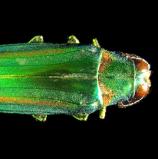
An international research team led by Yale University scientists has for the first time explained the preservation of colors in fossil insects.
The discovery shows why colors change during fossilization and reveals hidden gems among insect fossils that could help reconstruct the evolution of colors in these creatures.
“This information will help us work out what colors ancient insects were and what they used the colors for,” said principal investigator Maria E. McNamara. Co-authored with Yale paleontologist and Peabody Museum Director Derek E.G. Briggs and others, the paper appears online in the journal Geology.
Many modern insects owe their brilliant colors to microscopic light-reflecting structures in their cuticles, but the fossil record of these “structural colors” is patchy. Even where colors are preserved in fossil insects, they are not the original colors, which are altered during the fossilization process.
Using a novel experimental technique, McNamara’s interdisciplinary team simulated high pressures and temperatures in the laboratory, equivalent to those found in rocks that have been deeply buried over time. The modern beetles that the team used changed color during the experiments, due to alterations to the chemistry and physical architecture of the color-producing structures in their cuticles.
“One of our most exciting findings is that the structures that produce color in the living beetle survive in the fossils even where the color is no longer visible and the beetles have turned black,” said Briggs, whose lab hosted the research. ‘This means that we can reconstruct the original color even where it has been lost during fossilization.”
Co-author Zhengrong Wang, the Yale geochemist who designed the experimental apparatus, said the experimental technique used by the team has a rosy future. ‘This approach has broad applications and we plan to use it to investigate many other aspects of color preservation in fossil insects and other animals.”
McNamara conducted the research during a postdoctoral fellowship at Yale. She is now a postdoctoral fellow at Bristol University in the United Kingdom.
The paper, which includes a full list of co-authors, was published on line on Feb. 20 and will appear in the April print issue of Geology.
The research was supported by a Marie Curie International Mobility Fellowship through University College Dublin, and by the National Science Foundation.
by Eric Gershon